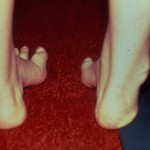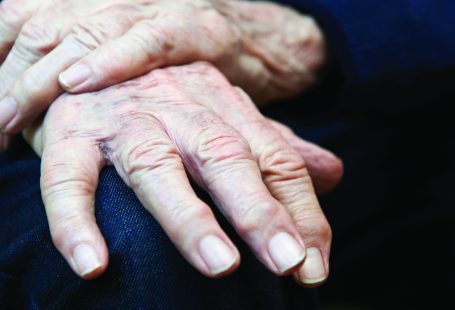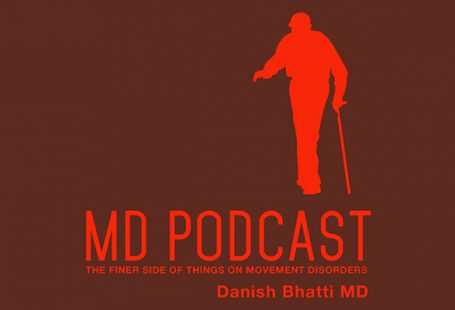
Danish Bhatti: Hi John. It’s a pleasure to have you here again to talk about some of your interesting cases and you know I learned a lot talking to you every week about these cases and I hope other people can also share my enthusiasm for these cases.
John Bertoni: Well thank you. I find that I’ve learned the most from the patients I say if you listen if you pay attention.
Danish Bhatti: I agree. So which patient would you be telling us about today?
John Bertoni: Well this is going to be a surprise. I’ll tell you about the patient and see if you can figure it out on the way wherever he’s listening.
Danish Bhatti: Can you also give me a context of when you ran into this patient? What were you doing at that time?

John Bertoni: I was at the University of Michigan Medical Center, my first year of a residency in neurology. We met with the senior residents that were leaving and they had particularly interesting cases and they would donate the case or pass the case and all patient along to one of the new residents and we had a chart back then they were big charts and he put it in front of me and said this is for you. This young woman has a spinal cerebellar degeneration. I said Okay. Which one. And he said something like Freidrichs Ataxia.
I may have actually been, since he was still there an intern, but I remember Arch Brickell was the doctor. A very smart guy but he was never in doubt about what the story was and usually very appropriately so. So he said it’s Friedrichs ataxia. Being a little OCD even back then. I looked through the chart and there were parts missing. I got them and I started going through to look for a family history to find out what the birth and development history was. But there were some things about this that just didn’t look right. I found out from the outside records which were back then copy very poorly and they were very hard to tell what was being said. A lot of it was handwritten. A lot of it was out of order but I think at about 18 months of age some abdominal catastrophe and had an operation, almost died. She had a very difficult course. The diagnosis was intussusception. So her abdominal catastrophe was most of her small intestine was dying. So they had back then an immediate laparotomy and they found that it was not going to survive and they cut out a large portion of her small intestine. I was fascinated. I don’t know that other people paid much attention to this and she had been normal until then. No family history of any freidrichs ataxia. Her story then was she barely survived. She had a lot of electrolyte disturbances got over that was sent home and had to have a special diet.

John Bertoni: So when I saw her, the story from the family was that they noticed when she got up for her graduation diploma in high school. They noticed that she wasn’t walking very well on her high heels. She had always been kind of frail by the time I saw her. She had a severe Ataxia. When I started working with her she had a strange voice that was ataxic. She had a significant peripheral neuropathy. I was very careful about my neurological examination. I think she had reduced reflexes but she may have had a Babinski sign. She had no perception, none; a vibration sense. You start in the toes and then you move up to the ankles still nothing, you know and the knees nothing, iliac crest nothing. You know along the dorsal spine nothing. I got to her sternum and she said Oh yeah I can tell yes it’s vibrating and I say how do you know that. She said I can start to hear it a little bit and the position sense was terrible and that’s one of the reasons she walked with a wide base gait. She had no idea where her feet were and I was very much bothered by this. So I thought it might be related to some sort of malabsorption. She had steatorhea – you know she had fatty unusual bowel movements all her life. And I just got to thinking there’s something weird about this. She had Ataxic eye movements. She had a strabismus – when I went in one direction the other one went in another. She had a very high pitched squeaky voice. She had a lot of Ataxia at her periphery. So when she reached for a glass of water she picked it up she’d spill part of it and was very, she had to use two hands. I’m trying to remember this. I haven’t reviewed the case but I did eventually write it up and I decided to propose that we evaluate this young woman, in a new area, we just had it University of Michigan, the clinical research unit. I think at that time by the time I got her into the ICU I had been finding out that there were abnormalities or B12 level was normal. Other things were normal but Vitamin E was very low. I did some research and found that there was a model by a Dr Pennchef who had done study of rats deprived of vitamin E and they had scoliosis. They had pathology in the dorsal columns really severe like she did because of vibration sense was gone. They had Ataxia. They had scoliosis if I didn’t mention it and I also found that she had an abnormality. She had an anemia a macrocytic anemia.
Danish Bhatti: Now this is we’re talking about 1980s early 80s.
John Bertoni: No still in the 70s.
Danish Bhatti: 70s and vitamin E deficiency was not known.
John Bertoni: No but there was a inherited disorder called bassen kornzweig disease or something like that was related to abetalipoproteinemia, like you were saying that was negative. She didn’t have that disorder.
Danish Bhatti: But that was known to cause Ataxia.
John Bertoni: Yes. In fact when I saw that disorder I said that’s her. So and then I had other people work with me on this again I enlisted somebody from Ophthalmology, a GI expert who was really well known in the field. Somebody that did a retinal visual evoked potentials. He was from the Middle East and he was one of the rare few people who could do this. I got a dermatologist. We did skin biopsies, a neuro pathologist we did muscle and nerve biopsies. And we did a real good evaluation of this young lady.

Danish Bhatti: And you know you’re referring to some rat models. That means that the human Vitamin E deficiency state, (was not described) effects were not known.
John Bertoni: No in fact vitamin E had, It was thought to be a bogus.
Danish Bhatti: And the levels could be tested commercially.
John Bertoni: Yes I had to send them out to a special lab and I mean if let’s say the level had to be 20, her’s was practically undetectable. So once I noticed that she had what looked like bone spicule retinal degeneration that was seen in some known disorders that were categorized as a spinocerebellar degeneration. Ophthalmologist just were really really interested in this case. And so there was something that they used dark adapted visual fields. So what they did is they put somebody in a very dark room and then let the vitamin A regenerate and then you did visual fields. And when her visual fields were in dark light. They were very constricted. So the rods and the cones, the rods tend to be outside you know in the cones or in the middle in the macula area. So in order to see a dim star for example if you look right at it you don’t see it at night. If you look off to the side where your rods are more sensitive to dim light you can see it but you know it’s that kind of thing. So we were intrigued by all this that she had. Never seen a case like this. At that time, we were thinking mainly of vitamin A. So we treated her with high doses of vitamin A and her visual fields had been tested enough ophthalmology department for years. Amazingly normalized quite a bit not back to normal but 50 percent back to normal. Her Ataxia got better she was now I don’t think she was able to walk in high heels her position since got a little bit better or sensation got better.
Danish Bhatti: So did you replace the vitamin E.
 John Bertoni: We eventually did. We put all this together we showed the vitamin E in all the other levels we sent it into the Journal ‘neurology’ and then Bud Rowland from Columbia (university) was the editor of neurology and it was turned down. Back then I presented this also at the American Neurological Association the ANA. It was a platform presentation and they had some so called expert come in and do his critique of what my work was. And after I presented it. it was probably one of the first presentations ever made. We had a lot of data and I sat down and the guy ripped all my assumptions to shreds. He said this is inherited disorder it’s got to be one of the spinocerebellar degeneration. And I said Well which one? which one is it most like? And he couldn’t come up with an answer. And I said you know we did this electroretinogram on family members too. We couldn’t find anybody else in the family that had her abnormal electroretinogram.
John Bertoni: We eventually did. We put all this together we showed the vitamin E in all the other levels we sent it into the Journal ‘neurology’ and then Bud Rowland from Columbia (university) was the editor of neurology and it was turned down. Back then I presented this also at the American Neurological Association the ANA. It was a platform presentation and they had some so called expert come in and do his critique of what my work was. And after I presented it. it was probably one of the first presentations ever made. We had a lot of data and I sat down and the guy ripped all my assumptions to shreds. He said this is inherited disorder it’s got to be one of the spinocerebellar degeneration. And I said Well which one? which one is it most like? And he couldn’t come up with an answer. And I said you know we did this electroretinogram on family members too. We couldn’t find anybody else in the family that had her abnormal electroretinogram.
Danish Bhatti: Why was it so hard to believe that vitamin deficiencies can cause this?
John Bertoni: I don’t know. It’s because people didn’t recognize these things. You know it was just. I think it was only recent knowledge that the abetalipoproteinemia bassen kornzweig syndrome, could be treated and babies were being treated from the get go if they were diagnosed correctly. She did better and better.
Danish Bhatti: So you got published in Neurology Journal.
John Bertoni: No, they turned it down. So but we had the abstract in the proceedings of the American Neurological Association. At least I had my citation for the first adult case of vitamin E deficiency.
Danish Bhatti: Did you ever publish in any of Journal?
John Bertoni: We did eventually publish it years later when I was in Texas. I went there in 1979 for my first job. I invited her (patient) to come down. I think they sometimes would winter in Texas. So I did a grand rounds on the patient. So I presented her as the case and it was really gratifying to see that she had improved and was thriving still had problems with dark vision still had some Ataxia but much better than she was. So in other words the lessons here are: If you have a suspicion or if you’re not sure because the patient doesn’t fit the typical picture. Go back and go to square one. Think again. My adviser told me he was going to forbid me from doing this. I’m glad I did. I looked him in the eye and I said, You don’t have all of my time. I can do this on my own time. I think this is important. He said, No it’s just a vitamin B 12 deficiency. I said well we’ll check for vitamin B 12 but it’s not you know and that’s one of the things I’m most proud of. I stuck to my guns at that point. I was just beginning in the opposition that you get it from coming up with a new idea or a new approach. Its not malicious. It’s just the way people are. If you’re coming up with a new idea they say well who are you to say that you’re discovering or finding something.
Danish Bhatti: Do you think you’re being a junior of first year neurology resident played a part in it and all these guys was way senior somebody like Bud Rawlins?
John Bertoni: Of course. But I saw Bud Rawlins at a later American Academy of Neurology meeting and I challenged him. He told me we just didn’t believe it. There’s nothing, you can’t take these things personally. It’s just that there will be opposition to any change. People are averse to change and you know there’s a lot of wrong ideas they get promulgated. The thing that I liked the best about this whole story is that I found something wrong with somebody that nobody thought of before and we improved your life. That’s the main thing. The second one was I learned a lesson about sticking to my guns and an Emory Kochman who was a mentor of mine. We talked about him today. A Turkish gentleman a fine doctor went to Mayo Clinic an ex Turkish wrestler who was bombastic. I remember presenting this to a small group. It wasn’t even there was just a research meeting. And he said I think John is onto something. He was the first guy That really thought other than the people I was working with and helping me with the paper. Well I found out was that it was published in Neurology later. The initial abstract presentation was in 1978. This actually got published in 1984 in neurology Volume 34 number 8 in August 1984, pages 1046 to 1052. Back then they wrote you a letter please send me a reprint. Before they had Xerox machines. That’s how long ago this was.
Thank you so much. It’s remarkable how fascinating the world of movement disorder is just to look at one facet of it can mesmerize you. I hope you are as thrilled about today’s episode. Your feedback and suggestions are highly appreciated. So write to us at ejazlearning@gmail.com. and follow me on Twitter at Danishbhatti_MD. Hope to see you next time. Ciao ciao.




